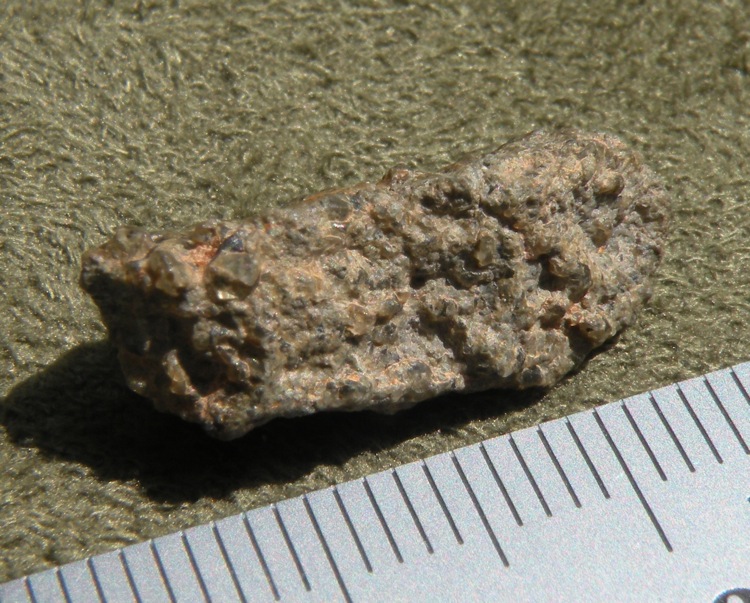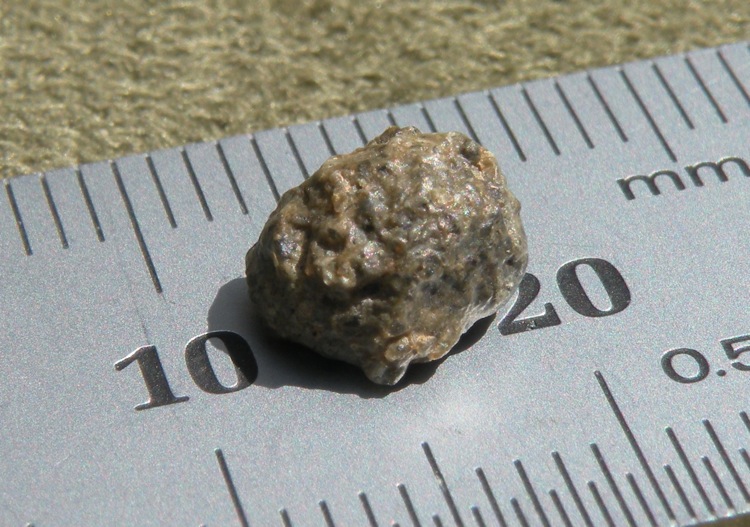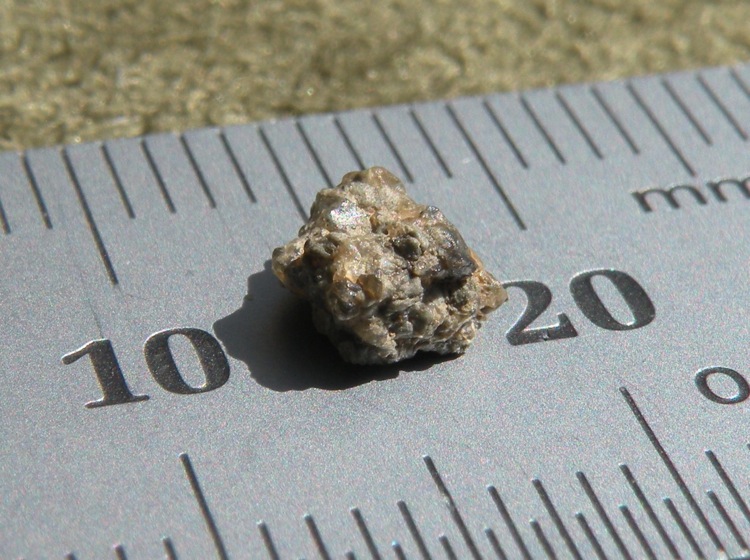|
|
These small, complete martian stones are paired with NWA 2975 as well as its several pairings. I'm not entirely sure if it's officially "ok" to use the number NWA 2975, though, so for all intents and purposes, these stones should be deemed uncassified Northwest African shergottites.
A complete list of pairings is available at the following page -
http://www.meteoris.de/mars/list.html
Writeup from MB 90:
Northwest Africa 2975
Algeria
Find: 2005
Achondrite (Martian, basaltic shergottite)
History: A minimally weathered fully encrusted whole stone of 70.1 g was purchased in Erfoud, Morocco, by M. Farmer in November 2005.
Petrography: (T. Bunch and J. Wittke, NAU; A. Irving, UWS) A medium-grained (<3.1 mm greatest dimension) basaltic shergottite that consists of ~57.3 vol% augite and pigeonite pyroxenes, and 38.3 vol% plagioclase (present as shock-formed maskelynite and glasses) with minor opaques (2.7 vol%) and phosphates (1.7 vol%) arranged in a weakly foliated subophitic to granular texture. Accessory phases include ulvöspinel, ilmenite, chlorapatite, merrillite, pyrrhotite, Si-Al-Na-K-rich glasses, and baddeleyite. Vesicular black glass veins (<3 mm in width) and pockets (up to 6 mm) are prominent.
Geochemistry: Pigeonite (Fs35.2–57.6Wo12.6–16.5; FeO/MnO = 28–38) and augite (Fs27.2–41.5Wo30.8–35.2) show mottled compositional zoning. Fe-rich margins of pigeonite contain very thin (0.2–0.5 µm) orthopyroxene exsolution lamellae. Maskelynite is compositionally homogeneous An55Or1.8 in contrast to mesostasis maskelynite (An48–60Or9.2) and glasses. Melt inclusions (15–60 µm, longest dimension) in ulvöspinel have rims of Fe-rich pigeonite (Fs73.5Wo5.8), merrillite, and pyrrhotite; cores are Si-Al-K-Na-rich glass. Bulk composition: Calculated average bulk composition based on analyzed phases and their modes of three melt inclusions is: SiO2 = 70.2, Al2O3 = 8.5, TiO2 = 0.8, FeO = 2.1, MnO = 0.2, MgO = 2.35, CaO = 3.5, Na2O = 0.95, K2O = 2. 1, and P2O5 = 2.8 (all wt%) with trace amounts of NiO, CoO, and S. One melt inclusion contains only fayalite (Fa84) mantled around a core of glass (K2O = 6.4, SiO2 = 78; both wt%).
Classification: Achondrite (Martian basaltic shergottite); moderate to high shock, minimal weathering.
|
http://www.lpi.usra.edu/meteor/metbull.php?code=33425
Martian meteorites are exceedingly rare, and are at this point less common than their lunar counterparts. There are currently 56 known distinct meteorites from Mars (as of July 2011); this is a rare chance to own an individual from one of those falls.
They're from Mars. That's pretty darn cool.
I just donated one of these NWA 2975 stones to UC Berkeley for a study trying to piece together past compositions of the Martian atmosphere using gasses trapped in shergottites; these rocks are definitely of scientific worth.
Part of the reason I was asked for a piece of this meteorite is because it's largely made of large maskylenite crystals, the glassy knobs poking out of most of the ses stones. Those same crystals are apparently good at trapping radiogenic gasses like argon, which is what's being studied right now.
1.646 grams





This is a fragment with a few patches of thin secondary crust (see black patches in the first and last photo). It's full of easily visible large maskelynite (glassy, shocked and recrystallized plagioclase feldspar) crystals -- it's a heck of a nice chunk of Mars.
$570
Send an Email
0.281 grams



This is a sandblasted individual/fragment that also exhibits fine large maskelynite crystals.
$100
Send an Email
0.140 grams (#1)



Another fragment with huge, knobby maskelynite crystals.
$55
Send an Email
0.435 grams





This one has some dark shock discoloration, probably from the impact that ejected this stone from Mars -- and is covered with clear maskelynite knobs.
It's a good solid chunk.
$150
Send an Email
0.159 grams



This one is darker and more highly shocked than most of the others. It has a few large maskelynites - I can't tell if it's a sandblasted individual or a fragment.
$601
Send an Email
1.138 grams




Crust! This one looks like a half individual. Again with the semi-translucent maskelynites, especially on the broken side.
$420
Send an Email
0.091 grams




This one was a little more sandblasted -- which brought out some of those huge maskelynite crystals. Check out that second photo.
$35
Send an Email
0.336 grams



A fragment with a side of sand-blasted crust - nice chunk, good crystals.
$120
Send an Email
0.140 grams




Another highly shocked piece - the first two pictures show a black shock-vein cutting right across the stone.
$55
Send an Email
0.546 grams




One of the prettiest in the lot, in my opinion. ~55% crust, a clean break to see the inside. Pretty, better in person.
$2000
Send an Email
0.094 grams


Another nice complete desert-varnished fragment with large maskelynites...
$35
Send an Email
0.810 grams





Mostly complete individual with crust on the back, traces of crust (and shock veins) on the front - the fourth picture shows some great coarse interior texture reminiscent of Los Angeles 001/002.
$280
Send an Email
0.375 grams




Great shock vein! And some crust, maskelynite, etc. Nice piece.
$1300
Send an Email
0.085 grams




Large clear maskelynite crystals.
$35
Send an Email
fragments


Mars. Very small pieces of the planet. Some maskelynite.
$10 including box, $13 total including US shipping. $17 total for international.
Send an Email
|
